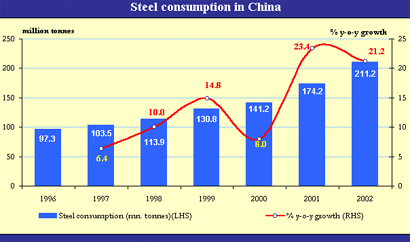China
01 Jan 1900
The improvement in world steel prices since December 2001 is largely attributable to the Chinese import surge.
In 2002-3, China produced 180 million tonnes of steel and imported some 30 million tonnes. Last year, 81 per cent of the incremental global steel demand of 46 million tonnes came from China.
This year, China is expected to produce 200 million tonnes of steel, but it will still import 20 million tonnes. As a result, the International Iron & Steel Institute (IISI) is cautiously optimistic that the world consumption of steel will grow by 4.6 per cent in 2003.

As a result India has exported more steel to China during the first six months of calendar 2003 than it has exported during the past four years. As a matter of fact, steel exported during the six-month period this year is almost double in value terms as compared to the total exports during the previous four years.
According to data available from the ministry of steel, the value of steel exported to China during January-June stands at $621 million, which is 137 per cent more than the total exports worth $262 million during the whole of 2002.
And going by the available indications, officials in the steel producing companies believe that the total exports in the second half of calendar 2003 is expected to be substantially higher than that during the first half of the year.
Even during the year 2002, the total exports were more than four times the total exports to China in the year 2001.
| India's exports to China ($ mn.) | |
| Period | Value |
| Jan-Dec 1999 | 5.0 |
| Jan-Dec 2000 | 20.0 |
| Jan-Dec 2001 | 64.0 |
| Jan-Dec 2002 | 262.0 |
| Jan-Jun 2003 | 621.0 |
Government sources say that the visit of a steel ministry delegation to China in May this year headed by the Union steel minister has also paved the way for increased use of Indian steel in Chinese construction activities following a dialogue at the highest level.
Indian companies are exporting products such as special steel, hot and cold rolled coils, galvanised coils and pre-painted coils to the Chinese market.
The good news for Indian steel producers is that though China is importing less steel this year compared to last year, the quota for India has been kept at the same level as last year's 1.2 million tonnes.
Already, China has emerged as a big market for Indian companies: it accounts for 29 per cent of Tata Steel's exports and 35-40 per cent of Sail's exports.
According to industry sources the entire increase in price and demand is due to China and as long as this demand is sustained, and China is preparing for the Olympics, there is no reason for prices to fall.
But China has given some anxious moments to the Indian steel industry. In late March, international prices started declining primarily because Chinese prices were falling. The reason was that during January-March, there was a large inventory build up in China ahead of the declaration of new quotas in May. However, things have looked up since then. China's imports in the four months to July have gone up three-fold as compared to the same period of the previous year.
At the same time, the huge inventories piled up in Russia and a few other countries in Eastern Europe have been depleted following a global economic pick up. Cheap imports from these countries had held global steel prices under check. But now Russia is showing a strong growth in demand and is now importing steel.
The result of this is for all to see. India's first quarter steel exports are up by 40 per cent this year as compared to the previous year. All the steel producers are now confident of exceeding their export targets for the year.
Sail, for instance, had projected exports of one million tonne during the year. It has already done a third of that in the first quarter.
What's more, the uptrend in global steel demand and prices is expected to continue for a few more years and the OECD is seriously debating a proposal to shut unviable steel mills that produce around 100 million tonnes amongst the member nations.
Analysts believe that though it is likely to be done gradually, steel prices can be expected to rule firm because of it.
Clearly, happy days are here again
| Share in total global crude steel output | |
|
| Per cent |
| China | 22.5 |
| Japan | 11.4 |
| United States | 9.5 |
| Russia | 6.4 |
| South Korea | 4.8 |
| Germany | 4.3 |
| India | 3.3 |
| Brazil | 3.3 |
| Italy | 2.9 |
| France | 2.2 |
| Chinese Taipei | 2.0 |
| Turkey | 1.9 |
| Mexico | 1.6 |
| Canada | 1.6 |
| Spain | 1.5 |
| United Kingdom | 1.3 |
| Others | 19.3 |
| Total All countries | 100.0 |






















